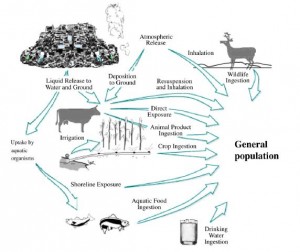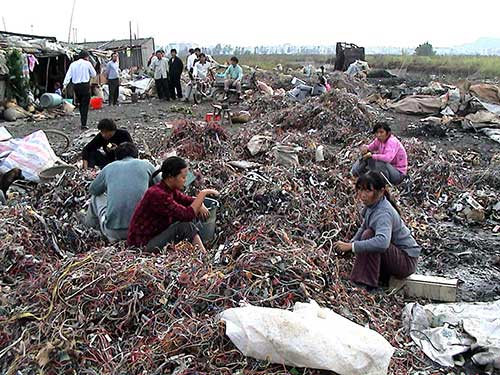Life was much quieter and simpler when I started my HSE careers in the late 1970s – no electro-house music, no mobile phones, no personal computers, no internet, and no e-waste!
Now computers, mobile phones, TVs and other electronic equipment can be found worldwide, even in the poorest communities. While the electronics/internet age unarguably has had profound benefits it also comes with costs, not least of which is the increasingly large quantities of waste electrical and electronics equipment (e-waste) that need to be managed.
We’ve created a throw-away society of these products – even the newest model of phone or computer are deemed obsolete by most users after a few years. As a result, e-waste is now among the fastest growing waste streams globally.
The problem is of course not just the vast quantities involved, but, also the toxic compounds associated with e-waste and the associated health, environmental and social impacts.
In this blog post I’ll explore the issue of e-waste management by discussing the sources and characteristics of e-waste, legal and regulatory issues, health and environmental impacts and close the post by offering suggestions as to what HSE professionals can do to most effectively manage e-waste streams at their facilities.
What is e-Waste?
(Step Initiative 2014) defines e-waste as “a term used to cover all items of electrical and electronic equipment (EEE) and its parts that have been discarded by its owner as waste without the intent of reuse”. They also note that it is a complex and fast growing waste stream with significant resource recovery potential but also with many environmental, social and health considerations that makes it particularly difficult to manage.
According to a recent UNA-IAS report, e-waste amounted to 41.8 million tonnes in 2014 and the US and China discarded nearly one-third of the world’s total. More specifically, e-waste in 2014 comprised:
- 12.8 million tonnes of small equipment (such as vacuum cleaners, microwaves, toasters, electric shavers and video cameras)
- 11.8 million tonnes of large equipment (including washing machines, clothes dryers, dishwashers, electric stoves, and photovoltaic panels)
- 7.0 million tonnes of temperature-exchange (cooling and freezing equipment)
- 6.3 million tonnes of screens
- 3.0 million tonnes of small ICT equipment (phones, PCs, etc)
- 1.0 million tonne of lamps
The UNA-IAS report noted that with respect to resource recovery potential, e-waste discarded in 2014 contained some 16.5 million tons of iron, 1.9 million tons of copper, and 300 tonnes of gold as well as significant amounts of silver, aluminum, palladium, and other potentially reusable resources, with a combined estimated value of US$52 billion!
 Metals in a typical mobile phone (image from www.Coden.jp)
Metals in a typical mobile phone (image from www.Coden.jp)
Legal and Regulatory Issues
The Basel Convention first addressed e-waste issues in 2002 which included, among others aspects, environmentally sound management, prevention of illegal traffic to developing countries, and building capacity around the globe to better manage e-waste.
Since then, many Asian countries have legislated – or are in the processing of doing so – electronic waste recycling. South Korea, Japan and Taiwan lead the way by requiring that manufacturers are to be responsible for recycling 75% of their annual production. China and India are primarily focused on preventing e-waste material imports, as unscrupulous recycling activity is proving to be a major health and environmental problem, particularly in poorer regions.
However, e-waste legislation and regulations across most of Asia (and the developing world as a whole) is a work in progress. Check you local regulator for your requirements and make sure that you follow up regularly as these regulations are rapidly evolving. As an aside, if you don’t have an HSE Legal Register, then you need to develop one (as discussed in a previous blog post) or hire a service to provide one for you (contact us and we’ll be pleased to help).
Environmental and Health Impacts
There are a myriad of environmental and health impacts associated with e-waste; Robinson (2009) provides a good overview:
“E-waste contains…potential environmental contaminants, especially Pb, Sb, Hg, Cd, Ni, polybrominated diphenyl ethers (PBDEs), and polychlorinated biphenyls (PCBs). Burning E-waste may generate dioxins, furans, polycyclic aromatic hydrocarbons (PAHs), polyhalogenated aromatic hydrocarbons (PHAHs), and hydrogen chloride. The chemical composition of E-waste changes with the development of new technologies and pressure from environmental organisations on electronics companies to find alternatives to environmentally damaging materials. Most E-waste is disposed in landfills. Effective reprocessing technology, which recovers the valuable materials with minimal environmental impact, is expensive. Consequently, although illegal under the Basel Convention, rich countries export an unknown quantity of E-waste to poor countries, where recycling techniques include burning and dissolution in strong acids with few measures to protect human health and the environment. Such reprocessing initially results in extreme localised contamination followed by migration of the contaminants into receiving waters and food chains. E-waste workers suffer negative health effects through skin contact and inhalation, while the wider community are exposed to the contaminants through smoke, dust, drinking water and food. There is evidence that E-waste associated contaminants may be present in some agricultural or manufactured products for export.”
Why Should You Care?
Why should you be concerned about e-waste? After all, this is an issue that is of little direct impact on you and your workers (unless you work at an e-waste recycling facility). So as long as you are sorting your waste and disposing of them in accordance with local regulations then why be concerned?
Why? Because, I am hoping that as an HSE professional you have a desire to look beyond the direct impacts and are also interested in a wider view of HSE. That is, to understand and appreciate how your actions (in this case e-waste management) might affect other workers, the general population and the environment. (And, I suspect those that don’t care about this broader view are unlikely to read by blog posts in the first place!)
Risks of e-waste for health sustainability of the general population exposed to e-waste scenarios are related to illicit dumping, crude recycling and improper treatment and disposal. In addition to occupational and direct local exposure, e-waste scenarios may impact on the environment-to-food chain, thus eliciting a widespread and repeated exposure of the general population to mixtures of toxicants. Frazzoli et al (2010) provides a simple summary diagram of the exposure’s routes and fate and behaviour of e-waste related mixtures of toxicants in the environment, including contamination of food chains.
OK. Agreed This is a Serious Problem. But, What Can I Do?
As a starting point, make sure that you have in place a waste management plan and to follow-up to make sure the waste is being disposed of in accordance with your expectations – see my previous blog posts on waste management and hazardous waste management for more information on these issues.
What can you do if your company operates in an areas with no proper disposal facilities and/or no formal recycling for e-waste? In many such countries, informal sectors play significant roles in recycling, the so-called “backyard recyclers”. The problem of course with the informal recycling sector is there is no attention paid to worker’s health, environmental releases and exposure to general population. Plus, there is a loss of economic opportunities (e.g., incomplete recovery of precious metals) and materials are wasted that could be used elsewhere.
So, what can be done? Of course ultimately one hopes for improved policies, regulations and guidelines along with enforcement and compliance. But that does nothing for the HSE professional who is today facing the challenge of managing e-waste on site. I offer a few recommendations below and my readers will likely have others to consider.
Prevention and Minimizing the Generation of E-Wastes
This is an obvious first step for all waste management programs, both for hazardous and non-hazardous wastes, and can provide multiple benefits including lower expenditures, material and waste management costs. This can include using equipment longer (do you and your staff really need a newer mobile phone or computer?), repairing equipment to keep it functional longer, donating old and workable electronic equipment to schools or charities, etc.
Time and Storage
For most companies, e-waste is a relatively small waste stream. Electronic equipment poses effectively no risk to people or the environment until it is taken apart and/or treated by various means for recovering precious metals. In this case, why not simply store the e-wastes on site in a garbage bin or container? For most companies, e-waste will be able to be stored for many years (and probably even decades) without noticeable operating impacts. Presumably, this will provide time for local regulatory conditions to change and environmentally and socially responsible solutions be implemented for e-waste in your country.
Get Involved and Look for Local Solutions
While this may not be at all practical for many, if you do live in an area with like-minded HSE professionals there may be opportunities to work with local regulators, international organizations and/or local entrepreneurs to seek local solutions, e.g., Clean-India Initiative. Or, look into opportunities to join non-profit groups such as the Basel Action Group’s e-Steward Program. In other words, don’t simply throw up your hands in defeat, get involved and be part of the solution.
Follow the Local Practice
When all else fails, despite your best intentions, you may be forced to dispose of your e-waste because of corporate requirements. If that is the case, do this in a responsible manner, with the understanding that even when following local regulations you may end up using ill-qualified and non-reputable (albeit government-approved) waste management companies. In such a case, be aware that in all likelihood this waste is going to be disposed of in an uncontrolled landfill (i.e., garbage dump) and the e-waste will likely be salvaged for crude recycling purposes by waste pickers, and often bare-footed children. While I certainly have empathy for these poor and vulnerable groups of people, at the same time I do not personally want to add to their health risks. For small amounts of e-waste, I suggest exploring protecting these people and the environment from the e-waste via stabilization/solidification with concrete. For instance, place the e-waste in a 45-gallon drum and then fill with concrete. While this is not ideal, it can be done with minimal cost and serves the dual roles of partially stabilizing/sealing the waste to minimize leaching of heavy metals to the environment and preventing access of the waste to waste pickers and informal recyclers.
I trust this is useful in some small manner for those with the challenging job of managing e-waste in developing countries. Please share your thoughts and insights in the comments sections below.
Thanks for reading. Keep safe. Be healthy. Respect your environment.
I hope that you will bookmark the blog, share it with your colleagues and visit the blog frequently because you find it informative and helpful. I value your feedback and suggestions for future topics.
Please enter your email in the box at the top of the post and subscribe to our blog HSE Asia – our weekly blog will be emailed directly to you.
Next Week’s Blog Topic: Perceived Risk and Worker Safety in Developing Countries or Why Do They Do That?
Photo Credits: E-waste image courtesy and copyright of Basel Action Network 2001.
- Is Your Business Compliant with HSE Regulations? Take Our Quiz to Find Out! - September 16, 2024
- Duty of Care: What it Is and What it Means to Companies Operating in the GCC? - January 28, 2024
- Free E-Book:Health, Safety, and Environment Regulatory Review – United Arab Emirates: An Overview of Federal Requirements - July 5, 2023
